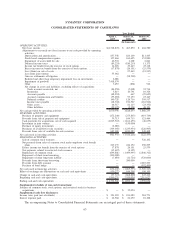Symantec 2009 Annual Report Download - page 131
Download and view the complete annual report
Please find page 131 of the 2009 Symantec annual report below. You can navigate through the pages in the report by either clicking on the pages listed below, or by using the keyword search tool below to find specific information within the annual report.current or long-term deferred tax assets and liabilities in our Consolidated Balance Sheets. Our judgments,
assumptions, and estimates relative to the current provision for income tax take into account current tax laws, our
interpretation of current tax laws, and possible outcomes of current and future audits conducted by foreign and
domestic tax authorities. Changes in tax laws or our interpretation of tax laws and the resolution of current and
future tax audits could significantly impact the amounts provided for income taxes in our Consolidated Balance
Sheets and Consolidated Statements of Operations. We must also assess the likelihood that deferred tax assets will
be realized from future taxable income and, based on this assessment, establish a valuation allowance, if required.
Our determination of our valuation allowance is based upon a number of assumptions, judgments, and estimates,
including forecasted earnings, future taxable income, and the relative proportions of revenue and income before
taxes in the various domestic and international jurisdictions in which we operate. To the extent we establish a
valuation allowance or change the valuation allowance in a period, we reflect the change with a corresponding
increase or decrease to our tax provision in our Consolidated Statements of Operations, or to goodwill to the extent
that the valuation allowance related to tax attributes of the acquired entities.
We adopted the provisions of FASB FIN 48, effective March 31, 2007. FIN 48 clarifies the accounting for
income taxes, by prescribing a minimum recognition threshold a tax position is required to meet before being
recognized in the financial statements. FIN 48 also provides guidance on derecognition, measurement, classifi-
cation, interest and penalties, accounting in interim periods, disclosure and transition.
FIN 48 prescribes a two-step process to determine the amount of tax benefit to be recognized. The first step is
to evaluate the tax position for recognition by determining if the weight of available evidence indicates that it is
more likely than not that the position will be sustained on audit, including resolution of related appeals or litigation
processes, if any. The second step requires us to estimate and measure the tax benefit as the largest amount that is
more than 50% likely of being realized upon ultimate settlement. It is inherently difficult and subjective to estimate
such amounts, as this requires us to determine the probability of various possible outcomes. We reevaluate these
uncertain tax positions on a quarterly basis. This evaluation is based on factors including, but not limited to, changes
in facts or circumstances, changes in tax law, effectively settled issues under audit, and new audit activity. Such a
change in recognition or measurement would result in the recognition of a tax benefit or an additional charge to the
tax provision in the period.
Earnings Per Share
Earnings per share — basic and diluted are presented in conformity with SFAS No. 128, Earnings Per Share,
for all periods presented. Earnings per share — basic is computed using the weighted-average number of common
shares outstanding during the periods. Earnings per share — diluted is computed using the weighted-average
number of common shares outstanding and potentially dilutive common shares outstanding during the periods.
Potentially dilutive common shares include the assumed exercise of stock options using the treasury stock method,
the dilutive impact of restricted stock, restricted stock units, and warrants using the treasury stock method, and
conversion of debt, if dilutive, in the period. See Note 8 for details of potentially dilutive common shares from debt
instruments included in the calculation of Earnings per share — diluted.
Stock-Based Compensation
We account for stock-based compensation in accordance with SFAS No. 123R, Share-Based Payment. Under
the fair value recognition provisions of this statement, stock-based compensation is measured at the grant date based
on the fair value of the award and is recognized as expense over the requisite service period, which is generally the
vesting period of the respective award. No compensation cost is ultimately recognized for awards for which
employees do not render the requisite service and are forfeited.
Fair Value of Stock-Based Awards. We use the Black-Scholes option-pricing model to determine the fair
value of stock options. The determination of the fair value of stock-based awards on the date of grant using an
option-pricing model is affected by our stock price as well as assumptions regarding a number of complex and
71
SYMANTEC CORPORATION
Notes to Consolidated Financial Statements — (Continued)
























